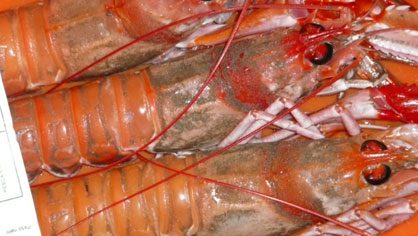1 June 2012
Work on a long-term plan for the North Sea Nephrops fishery has reached a critical stage in the North Sea Regional Advisory Council.
At a recent meeting, in the NFFO’s offices in York, a NSRAC focus group reviewed progress made to date and discussed next steps. To date, the North Sea RAC has:
- Developed a draft Long Term Management Plan for nephrops
- Discussed the details of the draft plan with fishing vessel operators in the main nephrops ports: North Shields, Pittenweem, Fraserburgh and Eyemouth
- Instigated a research project at the University of Newcastle on options for managing the nephrops fishery at Functional Unit level , focussing on the Farne Deeps , which has shown signs of stress by comparison with other functional units
The Focus Group agreed that considerable progress had been made so far, especially considering that this is ground breaking work which amounts to a serious effort to deliver comprehensive, bottom-up advice on a plan that would move us away from a poorly thought-through, often incoherent, short-term management decisions.
Nevertheless, there are a number of outstanding challenges:
- There is a problem of consistency and overlap with other fisheries plans; noticeably in this case with the EU Cod Management Plan
- To one degree or another, the nephrops fishery is a multi-gear fishery, a mixed fishery, affected by a range of multi-species issues. Scientific advice and management strategies to deal with mixed fishery and multi-species dimensions is still being developed; the challenge for the RAC is how to deal with this emerging perspective
- Dealing with ICES advice that nephrops should be managed at the functional level
- Developing a credible plan that takes functional unit management fully into account without tying the industry into a bureaucratic system of functional unit TACs
At the core of the NSRAC’s approach to functional unit management is the question of how to strike a balance between, on the one hand, administrative flexibility for vessels to move their fishing activity to different functional units with, on the other hand, providing adequate protection for those functional units showing signs of stress. Within this approach, the challenge is to identify concrete measures that would provide adequate protection at FU level but which would be broadly acceptable across the nephrops industry. The series of port meetings, and now the report from Newcastle University, underlined the range of views within the nephrops fleet on this issue. In general, local vessels want restrictions to prevent a recurrence of the kind of surge in activity in the Farne Deeps FU, that saw catches surge in 2006 from 2500 tonnes to something closer to 4500 tonnes. On the other hand, more nomadic fleets wish to maintain access, to all nephrops fishing grounds, even if that access to some areas is made conditional on supplementary measures.
The meeting considered that a menu approach might work, if different measures with broadly equivalent effect could be agreed; these would apply vessels fishing in the FU showing signs of stress, until it has recovered. For example, a visiting vessel wishing to fish in the Farne Deeps would select a condition that it could live with. These could be:
- Gear restrictions
- Additional quota constraints applied through POs (an ‘of which’ quota)
- Seasonal or time restrictions
- Other measures
It was agreed that the FU area could be zoned so that, for example, additional conditions could only apply inside 9 miles.
The aim is to maintain access to all FU areas for all vessels but to dissuade visiting vessels from over-exploiting the local grounds by raising the ‘price’ of entry, at least on a temporary basis. The choice of which condition would apply would lie with the vessel, within an overall framework.
The Group conceded that this is all new territory but that it is important to investigate new ways of managing the nephrops fishery in ways that avoid blunter, top-down, approaches such functional unit TACs or effort control, both of which carry significant disadvantages.
The Group has been encouraged by the example of the Porcupine Bank functional units in North Western waters, where a RAC proposal for a seasonal/area proposal seems to have stabilised the fishery without applying FU TACs.
The Farne Deeps has necessarily been the focus of this discussion in the North Sea, as it is the functional unit facing immediate stresses; but the Group suggested that it should begin work on parallel arrangements for the Fladden grounds to safeguard the most economically significant nephrops fishery in the North Sea. The immediate task will be to strengthen the knowledge base on the Fladdens as the basis of a further dialogue with the vessel operators on the specific measures. The measures would be held in preparation should the science suggest signs of stress on the Fladdens. Thankfully, at present the science suggests that the stocks are and the fishery are both stable.
The nephrops management plan is clearly important in its own right and there is a certain impatience to submit a plan sooner rather than later, if only to dissuade the Commission from proposing functional unit TACs. This work however has a wider significance as a possible template for stakeholder led long term management plans that embrace biological, economic and environmental dimensions.
The progress made will be reported to the Commission and also to the NSRAC Executive Committee which will decide on how this work will be taken forward.

